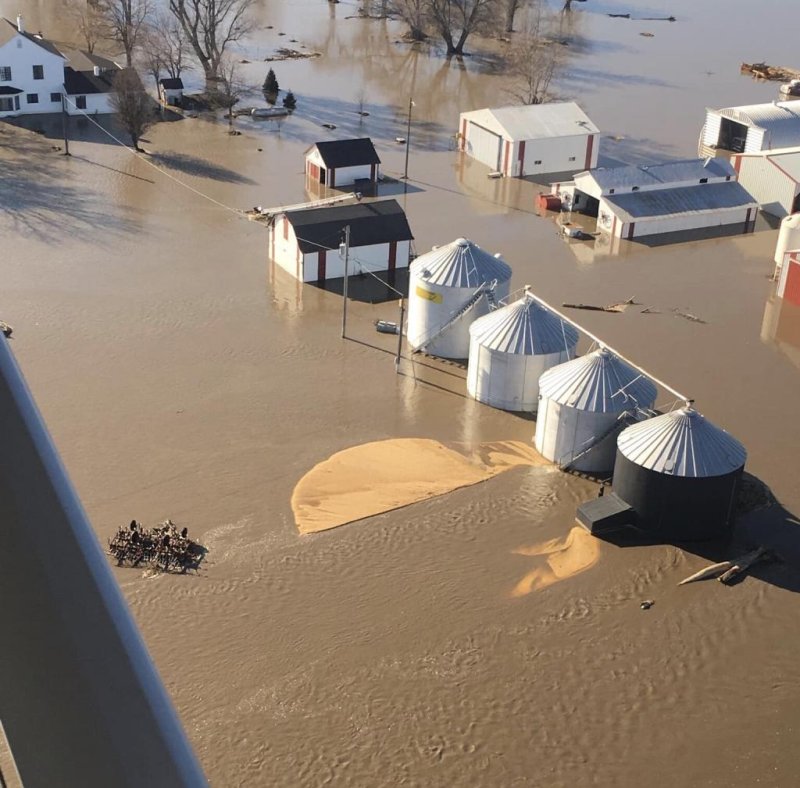1 of 2 | This aerial view of the flooded Kellogg family farm in western Iowa shows two burst grain bins with golden corn spilled across the ground. The crop stored in the secure bins also might be ruined. Photo courtesy of Beth Kellogg
EVANSVILLE, Ind., March 29 (UPI) -- Hundreds of millions of dollars in crops destroyed in Midwestern floods this month were not insured, farmers say. And the losses could leave many without sufficient income to continue farming.
"This uninsured grain issue is really starting to affect people," said Jeff Jorgenson, a western Iowa corn and soy grower whose farm flooded when the Missouri River spilled over its banks March 12.
"It could end a farming career," he said, his voice was full of emotion. "And that's all they want to do. You don't do this unless you have a love for it."
Jorgenson was lucky, he said. The levee protecting his farm held long enough for him to move his harvested corn and soybeans to higher ground. Most of his neighbors were not so fortunate.
About 10 miles west of Jorgenson's farm, the Kellogg family lost at least two grain bins full of corn -- and probably more. The water is still too high for them to inspect their remaining bins. That corn was not insured.
"Personally, I'm a mess," Beth Kellogg said. "I'm a wreck."
Like their neighbors, the Kelloggs purchase federally subsidized crop insurance. But that insurance covers crops only while they are in the fields, said Duane Voy, the director of the U.S. Department of Agriculture's Risk Management Agency's office that covers Iowa, Minnesota and Wisconsin.
Farmers buy insurance that will pay them if they are unable to plant -- for example if a flood renders the ground too wet. Policies are available that cover crops lost before harvest, such as from a drought. And some policies will make up the revenue difference when farmers' yields are lower than expected.
But all coverage ends the moment a crop leaves the field.
Some property casualty insurance plans cover stored grain, Voy said. Some flood insurance policies might also help. But those policies are not as ubiquitous as crop insurance. This spring's flooding inundated areas that never flooded before in collective memory, so many of the farmers impacted most severely didn't carry coverage.
"It's not cost-effective," Kellogg said. "It's flooded twice [at the farm] in the last 150 years."
That means that Kellogg, and other farmers like her, have lost the money they need to pay for this year's farming operations.
The 28 farmers in Fremont County, Iowa, where Kellogg lives, estimate they have lost some 390,000 bushels of soybeans and 1.2 million bushels of corn, said Jorgenson, who also lives in Fremont County. At their current price, that's around $7.3 million.
"That money buys seed, fertilizer and gas," Kellogg said. It also pays for equipment repairs and upgrades. And anything leftover comprises the family's personal income.
Compounding the disaster is historically low prices for commodity crops this year, which drove farmers to store more than normal. This was especially true for soybeans, for which the value has plummeted because of the trade war with China.
China usually buys around a third of all the soybeans grown in the United States, but that nation placed high retaliatory tariffs on them last summer, substantially reducing trade.
It's unclear how much crop the floods destroyed. Farmers and state workers still are trying to grasp the extent of the damage. Early estimates from Nebraska and Iowa (two of the hardest-hit states) put the total loss to agricultural at over $1 billion. That number includes dead livestock, damaged equipment and buildings, unplantable fields and lost crop stores.
Nebraska and Iowa estimate the total cost of the flooding is closer to $3 billion, and both states expect that figure to rise as the flood waters abate and more thorough inspections are done.
President Donald Trump declared major disasters in Nebraska on March 21, and in flooded Iowa counties on Saturday. The declarations make federal disaster relief money available in those area. For farmers, that means they may be eligible for loans to cover production and property losses. There also are loans to offset cash flow issues, according to the Federal Emergency Management Agency.
But even with that help, farmers in flooded areas are looking at a rough year, said John Hansen, president of the Nebraska Farmers Union.
The March 12 flood inundated the "500-year flood plain," Hansen said. In many places, the water is not retreating. Snowmelt from upriver is keeping waters high. The National Weather Service predicts flooding to get worse in some areas in the coming weeks.
Farmers who have lost their 2018 crops are now staring at flooded fields that may not dry out enough to plant this spring.
"Not everybody who got hurt will have the ability to come back," Hansen said. "The emotional loss of losing a farm -- it is equal to a grieving process for the loss of a family member. A lot of these farms have been in families for generations, and you're the one who lost it."
The Kellogg family has one of those multigenerational farms. Kellogg said her ancestors came to the United States from England in the mid-1600s. They first lived in Connecticut and then headed west to Ohio before settling in Iowa.
"They bought this ground for $1 an acre in 1857," Kellogg said. "And it's always been fertile ground that raised a good crop.
"I'm a fifth-generation farmer," she said. "My daughter was going to be the sixth generation; she moved back with her husband last year. She's devastated because she put all that hard work in last year and now [our harvest] is all over the ground."















